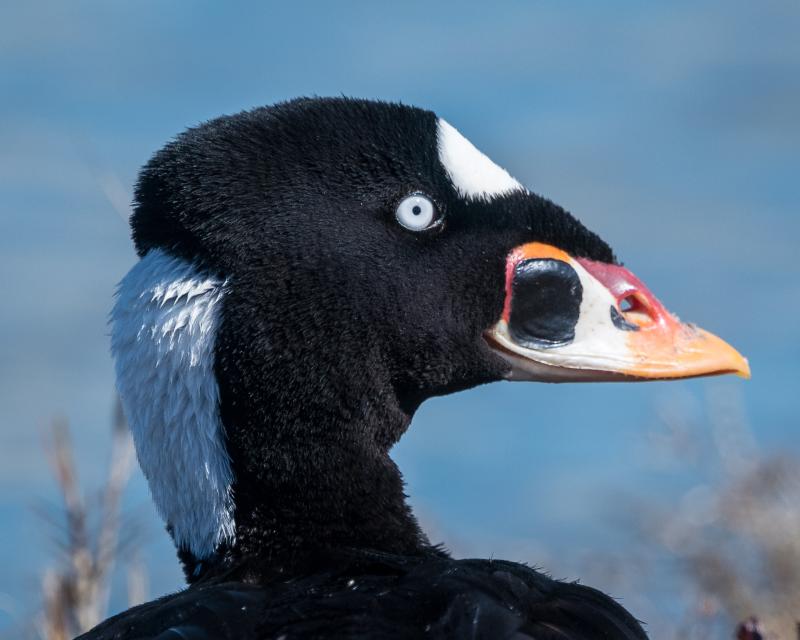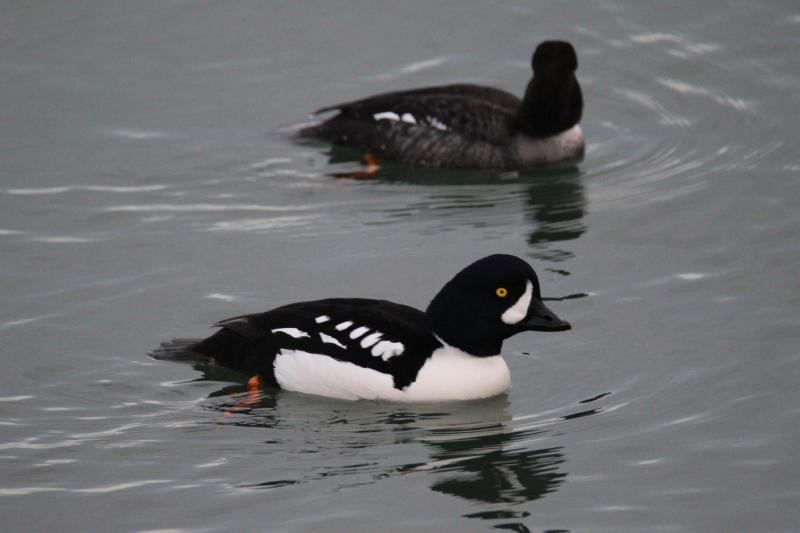An Abundance of Waterfowl
 Surf scoters are just one of the stunning waterfowl species that can be seen along the coast during our Maine winters. Photo by Becky Matsubara, courtesy of Wikimedia Commons
Surf scoters are just one of the stunning waterfowl species that can be seen along the coast during our Maine winters. Photo by Becky Matsubara, courtesy of Wikimedia Commons
 The population of Barrow's goldeneye in eastern North America is quite small and Maine is fortunate that we have them regularly, though in small numbers, each winter. Photo by DKRKaynor, courtesy of Wikimedia Commons
The population of Barrow's goldeneye in eastern North America is quite small and Maine is fortunate that we have them regularly, though in small numbers, each winter. Photo by DKRKaynor, courtesy of Wikimedia Commons
 Surf scoters are just one of the stunning waterfowl species that can be seen along the coast during our Maine winters. Photo by Becky Matsubara, courtesy of Wikimedia Commons
Surf scoters are just one of the stunning waterfowl species that can be seen along the coast during our Maine winters. Photo by Becky Matsubara, courtesy of Wikimedia Commons
 The population of Barrow's goldeneye in eastern North America is quite small and Maine is fortunate that we have them regularly, though in small numbers, each winter. Photo by DKRKaynor, courtesy of Wikimedia Commons
The population of Barrow's goldeneye in eastern North America is quite small and Maine is fortunate that we have them regularly, though in small numbers, each winter. Photo by DKRKaynor, courtesy of Wikimedia Commons
We are fortunate here in Maine that winter brings an abundance of waterfowl, including some species that can’t be seen in many other states. Common eiders make their downy nests on the ground on islands along our coast; during winter, they are joined by common eiders from farther north. During these winter months, a few of the much more northernly king eiders show up along our rocky coast. The male king eider has a powder blue head, orange face shield, and pink bill—an almost shocking burst of color to see bobbing in the waves.
The eiders are joined by other striking sea ducks like the three scoter species—surf scoter, white-winged scoter, and black scoter. Spend a little time at any rocky headland and you’ll almost certainly see all three of these striking species. Surf scoter males—black bodies contrasting with white patches on the back of the head and forehead and a yellow-orange bill—were sometimes called “skunk heads” by early waterfowl hunters. White-winged scoter males also have the yellow-orange color in the bill and are all black, in their case punctuated by a white patch near the eye and a white patch in the wing. Black scoter males are a velvety black with a shining orange bill. All three of these species nest in the Boreal Forest region of Canada and Alaska but brighten our coasts all winter.
We wrote a few weeks ago about one of the other very special sea ducks that winter here in Maine, the aptly named harlequin duck. They are an extraordinarily beautiful and very specialized northern sea duck that is typically found at only a few favored spots along the coast. And we haven’t even mentioned species like long-tailed ducks and red-breasted mergansers that like that open ocean habitat, too.
Other kinds of ducks prefer Maine’s more sheltered coves and bays in winter. Bufflehead, one of our tiniest winter waterfowl—jaunty birds in black and white plumage that usually stay in small flocks—occur by the dozens in many of our coastal estuaries. We always marvel at the numbers we see in the Sheepscot River in Wiscasset and in the Damariscotta River at Damariscotta. Like the scoters, bufflehead also nest in the Boreal Forest of Canada and Alaska.
Common goldeneyes likewise seem to prefer the more sheltered spots along our coast and also are found inland on larger rivers and lake outlets that remain unfrozen. Common mergansers join them on the free-flowing rivers.
One of Maine’s special wintering duck species is the Barrow’s goldeneye. In North America, the eastern and western populations of Barrow’s goldeneye are separated by more than a thousand miles. The eastern population has been estimated at only about four thousand, and Maine has traditionally hosted small numbers at scattered locations at a few open spots on the Kennebec and Penobscot Rivers and scattered locales along the coast. Lately the numbers have been pretty scant, with fewer than five in most spots and often just single birds. That may be because waters to our north are remaining more open in winter, especially along the St. Lawrence where the bulk of the population winters. In fact, even this winter, eBird shows that there are flocks of 50-100 Barrow’s goldeneyes at multiple places in Quebec—within 50-80 miles of Fort Kent in northern Maine.
That’s just some of the bountiful waterfowl that you can see in Maine in winter, and with milder winters, there are more and more birds lingering here and there, sometimes in flocks with mallards and American black ducks. If you add all of them together, there are about 25 different species of ducks that have been documented in Maine from December 1, 2024 through January 12, 2025. We hope you will get out and see some of them!
Jeffrey V. Wells, Ph.D., is a Fellow of the Cornell Lab of Ornithology and Vice President of Boreal Conservation for National Audubon. Dr. Wells is one of the nation's leading bird experts and conservation biologists. He is a coauthor of the seminal “Birds of Maine” book and author of the “Birder’s Conservation Handbook.” His grandfather, the late John Chase, was a columnist for the Boothbay Register for many years. Allison Childs Wells, formerly of the Cornell Lab of Ornithology, is a senior director at the Natural Resources Council of Maine, a nonprofit membership organization working statewide to protect the nature of Maine. Both are widely published natural history writers and are the authors of the popular books, “Maine’s Favorite Birds” (Tilbury House) and “Birds of Aruba, Bonaire, and Curaçao: A Site and Field Guide,” (Cornell University Press).
























